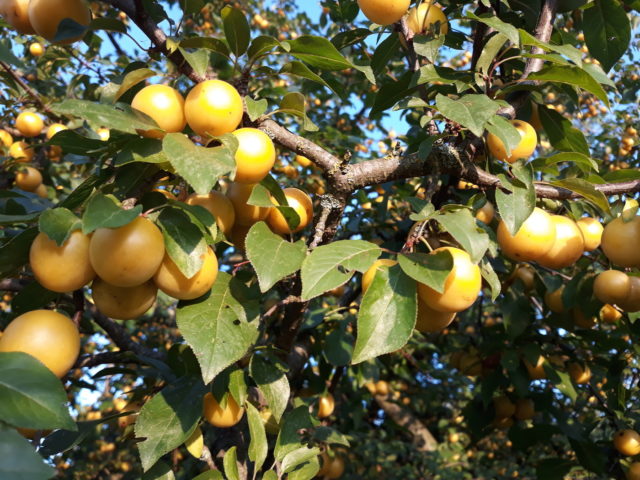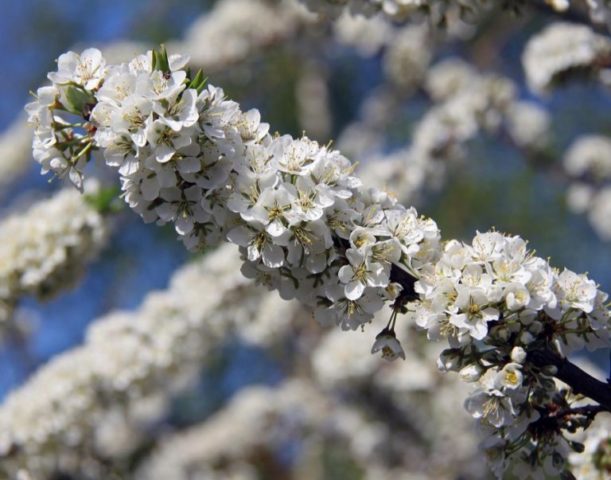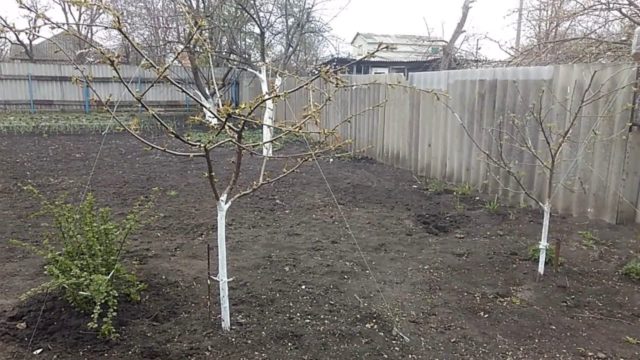Content
Cherry plum Gek is a hybrid variety popular among domestic gardeners. It has many advantages over other types of fruit trees. A description of the variety and a photo of cherry plum Gek will help you learn about the technology of growing this crop and the rules of caring for it. This will open up the possibility of obtaining a bountiful fruit harvest.
Breeding history
The Gek variety was bred at the Crimean experimental breeding station. The organizer of breeding works is Eremin Gennady Viktorovich. The variety was registered in 1991 for testing. Included in the register of breeding achievements of the Russian Federation in 1995.
Huck is the result of crossing a winter-hardy, early-growing Chinese plum with a hybrid cherry plum. Excellent student. According to other sources, the variety was obtained as a result of selection work, for which the Kubanskaya Kometa cherry plum and common apricot were used.
Description of the variety
Yellow cherry plum Huck is a medium-sized fruit tree. The plant is characterized by a rapid growth rate. The trunk is smooth, of medium thickness. The color of the bark is gray, with a few large lenticels.

Annual growth reaches 25 cm
Lateral shoots are thick - up to 3.5 cm. On young bushes, they are directed upwards. The branches acquire a horizontal position as they grow. Shoots have a dark charcoal bark. The average height of Gek cherry plum is 2.5 m.
Leaves are sinewy, ovoid. The color is bright green. The foliage on the shoots grows profusely. The crown is spherical, dense. The average length of each leaf is 6-7 cm, the width is up to 4.5.
During the flowering period, the tree is covered with two-flowered inflorescences. They grow densely on the shoots. Diameter - up to 2.2 cm. The color of the petals is white. The flowers have numerous yellow stamens 2-5 mm long.
Characteristics
Huck has a specific set of varietal indicators. Gardeners absolutely need to take these characteristics into account for the successful cultivation of a crop.
Drought tolerance, winter hardiness
Hybrid variety Huck is cold-resistant. This cherry plum can be grown in Siberia and other regions with an unfavorable climate. However, in order to obtain a regular and plentiful harvest, you will need to follow a number of agrotechnical rules.
The drought resistance of the Gek variety is average. The fruit tree tolerates a short-term lack of liquid.
Young plants are most sensitive to lack of liquid. Adult specimens tolerate adverse conditions better.
Cherry plum pollinators Huck
The variety is self-fertile. In the absence of pollinators, the plant practically does not bear fruit. This leads to the fact that the ovaries on the plant are not formed.
Any varieties of Russian plum or cherry-plum are used as pollinators. The only requirement is that their flowering period should be the same as that of the Geck variety.This ensures a full exchange of pollen for the subsequent abundant harvest. Most often, the varieties Nayden and Traveler are used as pollinators.
Flowering period and ripening time
The formation of buds takes place at the end of March. They bloom in early April.

The average flowering period of cherry plum is 2 weeks
Fruit ripening occurs in the second half of July. The fruiting period is up to 1.5 months.
The branches of the tree are highly durable and resilient. Therefore, they do not break under the weight of the fruit.
Productivity, fruiting
The Huck variety is versatile. It produces tasty, rounded fruits. The average weight of each is 30 g, they have a sour-sweet taste. They have a juicy yellow flesh that does not darken on air.

Cherry plum gek fruits have a small pit that is easily separated from the pulp.
Up to 45 kg of fruit can be harvested from one adult tree. On average, 35-40 kg of cherry plum are removed, subject to the presence of pollinators.
Scope of the fruit
Cherry plum Gek, due to its pleasant taste, is consumed fresh. Also, the fruits are suitable for conservation and various preparations. They make jam, jams, confitures from them. The sweet fruit goes well with a variety of fruits and berries.
Disease and pest resistance
The cherry plum variety Gek is characterized by an average resistance to infections. Under unfavorable conditions, violation of the cultivation technology or in the presence of an affected plant nearby, the fruit tree is exposed to diseases.
The Gek variety does not show specific resistance to insects. It affects most types of pests that spread on fruit trees.
Advantages and disadvantages
Hybrid cherry plum Gek is in many ways superior to other varieties. Therefore, this fruit crop is in demand among gardeners.
Main advantages:
- high productivity;
- unpretentious care;
- good taste of fruits;
- frost resistance;
- the possibility of growing in different regions of the Russian Federation.
Cherry plum Gek is characterized by good adaptive ability. The plant adapts to adverse conditions without sacrificing yield.
The main disadvantages of the variety:
- sensitivity to disease;
- the possibility of damage by pests;
- medium drought resistance;
- the need for pollinators.
The disadvantages of the Gek variety fully compensate for the advantages. Compliance with agricultural technology will allow you to get a good harvest every year without losses.
Landing features
The initial stage of growing cherry plum Gek is planting the plant in open ground. This procedure should be treated competently and responsibly. Improper planting can lead to wilting of the seedling.
Recommended timing
The optimal time for planting a plant is determined taking into account the climatic characteristics of the region. In the south and in the middle lane, cherry plum Gek is planted in the fall. The seedling will take root faster and adapt to the gradually increasing cold. Such a plant will show great resistance to temperature extremes.

Cherry plum is planted only when there is no risk of night frost
Spring planting is recommended in Siberia and other regions with cold climates. Young cherry plum is planted when a steady warming occurs.
Choosing the right place
Cherry plum Gek is considered an undemanding variety. But it is better to find a good place for the plant.
Primary requirements:
- loose fertile soil;
- lack of surface groundwater;
- strong wind protection;
- abundant sunlight.
It is not advised to plant cherry plum in lowlands, where water accumulates during precipitation. Also, do not land in the shade. Lack of sunlight negatively affects yields.
What crops can and cannot be planted next to cherry plum
When growing, it is necessary to take into account the specifics of the species compatibility of plants.The location next to the cherry plum of some crops will negatively affect the amount of the harvest.
You can not plant nearby:
- quince;
- apple tree;
- currants;
- raspberries;
- peaches;
- conifers;
- gooseberry.
Plum will be a good neighbor for hybrid cherry plum. You can also plant mulberries, apricots, walnuts nearby. Low-growing varieties of cherries and cherries are suitable for joint planting.
Selection and preparation of planting material
For cultivation, seedlings obtained by grafting or grafting are used. The optimum age for a young plant for planting is 1-2 years. Usually, seedlings are sold in containers with soil enriched with peat.
When choosing seedlings, you need to make sure that there are no defects. There should be a large number of buds on the roots. The main requirement is that there are no signs of decay or mechanical damage.
Landing algorithm
For growing hybrid cherry plum, a soil mixture of leafy and soddy soil in combination with peat and a small amount of river sand is best suited. If the acidity is increased, it is reduced with lime.
Planting stages:
- Remove weeds on the site.
- Dig a landing hole 60-70 cm deep.
- Place a drainage layer of expanded clay, crushed stone or pebbles on the bottom, 15-20 cm thick.
- Sprinkle with soil.
- Drive a support stake into the center of the pit.
- Place the seedling, straighten the roots, so that the head is at a depth of 3-4 cm.
- Cover the tree with soil.
- Tie to the support.
- Drizzle with water.
Cherry plum can be planted on small artificial hills up to 1 m in height. This will protect the roots from erosion and freezing.
Follow-up care of the culture
The Huck variety needs regular watering. It is held weekly. In summer, the frequency can be increased up to 1 time in 3-4 days. Young plants have the greatest need for liquid.
The first year after planting cherry plum Huck does not need to be fertilized. In the future, mineral and organic fertilizing is introduced. Nitrogen solutions are fed in early spring. Composition with potassium and phosphorus - after flowering. Organic matter is brought in in the fall. For these purposes, compost and humus are suitable.
Cherry plum is pruned in spring. Dried shoots are removed from the tree. Thinning of branches is carried out so that the crown is not too thick. Otherwise, the plant will experience a lack of light.

In the southern regions, it is not necessary to cover cherry plum for the winter, as it tolerates frost well.
In the Volga region and Siberia, the Gek variety is advised to close in late autumn. A layer of mulch from fallen leaves, tree bark, compost is scattered around the trunk.
Diseases and pests, methods of control and prevention
Insects often settle on the cherry-plum Huck. Some of them are capable of damaging the fruit crop.
The most dangerous are such pests:
- plum aphid;
- thrips;
- false shields;
- spider mite;
- plum sawfly;
- caterpillars of the American butterfly;
- moths.
In case of untimely harvesting, cherry plum can be chosen by bees and wasps. They eat ripe fruits.
As a preventive measure, trees are sprayed with karbofos. Use a 1% solution. In case of damage by insects, insecticides of a wide spectrum of action are used. Spraying is carried out twice with an interval of 2 days to 1 week.
The main diseases of cherry plum:
- brown spotting;
- clasterosporium disease;
- coccomycosis;
- moniliosis.
For the treatment and prevention of diseases, cherry plum Gek is sprayed with a solution of copper sulfate. For the same purposes, it is advisable to use fungicides. Processing is carried out in the early stages of the growing season until the formation of fruits.
Conclusion
Description of the variety and photo of cherry plum Gek will help both beginners and experienced gardeners. The presented fruit plant has many advantages. Cherry plum Gek is suitable for growing in almost any climatic zone. At the same time, the plant does not need complex and time-consuming care.








